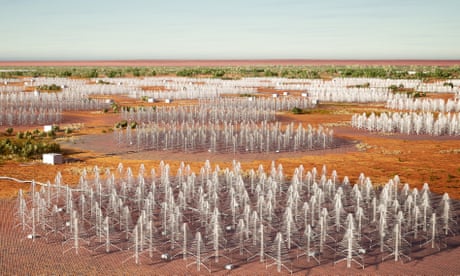- by foxnews
- 01 Mar 2025
‘Are we alone in the universe?’: work begins in Western Australia on world’s most powerful radio telescopes
‘Are we alone in the universe?’: work begins in Western Australia on world’s most powerful radio telescopes
- by theguardian
- 05 Dec 2022
- in news

Construction of the world's largest radio astronomy observatory, the Square Kilometre Array, has officially begun in Australia after three decades in development.
A huge intergovernmental effort, the SKA has been hailed as one of the biggest scientific projects of this century. It will enable scientists to look back to early in the history of the universe when the first stars and galaxies were formed. It will also be used to investigate dark energy and why the universe is expanding, and to potentially search for extraterrestrial life.
The SKA will initially involve two telescope arrays - one on Wajarri country in remote Western Australia, called SKA-Low, comprising 131,072 tree-like antennas.
SKA-Low is so named for its sensitivity to low-frequency radio signals. It will be eight times as sensitive than existing comparable telescopes and will map the sky 135 times faster.
A second array of 197 traditional dishes, SKA-Mid, will be built in South Africa's Karoo region.
The Australian minister of industry and science, Ed Husic, and the director general of the SKA Organisation, Prof Philip Diamond, are expected to mark the start of construction of SKA-Low at an on-site event in WA on Monday morning.
Dr Sarah Pearce, SKA-Low's director, said the observatory would "define the next fifty years for radio astronomy, charting the birth and death of galaxies, searching for new types of gravitational waves and expanding the boundaries of what we know about the universe".
She added: "The SKA telescopes will be sensitive enough to detect an airport radar on a planet circling a star tens of light years away, so may even answer the biggest question of all: are we alone in the universe?"
The SKA has been described by scientists as a gamechanger and a major milestone in astronomy research.
Prof Lisa Harvey-Smith, an astronomer at the University of New South Wales, called it a "a momentous day for global astronomy", adding: "Over a thousand people have worked for 20 years to make this a reality - and each will be feeling proud of this collective achievement today."
Dr Danny Price, a senior postdoctoral fellow at the Curtin Institute of Radio Astronomy, said the SKA's sensitivity would allow astronomers to peer back billions of years to the "cosmic dawn", when the first stars in the universe were forming.
"To put the sensitivity of the SKA into perspective, [it] could detect a mobile phone in the pocket of an astronaut on Mars, 225m kilometres away," Price said. "More excitingly, if there are intelligent societies on nearby stars with technology similar to ours, the SKA could detect the aggregate 'leakage' radiation from their radio and telecommunication networks - the first telescope sensitive enough to achieve this feat."
Prof Alan Duffy, director of the space technology and industry institute at the Swinburne University of Technology, said the SKA would probably be the largest telescope constructed, "connecting across continents to create a world-spanning facility allowing us to see essentially across the entire observable universe".
"The science goals are as vast as the telescope itself, from searching for forming planets and signs of alien life, to mapping out the cosmic web of dark matter and the growing of galaxies within those vast universe-spanning filaments," Duffy said.
"Just as with Hubble, the biggest discoveries by such next-generation telescopes are of things entirely unknown to science today. Astronomers worldwide will be celebrating this groundbreaking [development] for what it will mean for scientists in the decades ahead."
In Australia, the SKA Organisation is collaborating with the CSIRO to build and operate the telescopes.
- by foxnews
- descember 09, 2016
Major US city looks to hike hotel fees to boost tourism
Hotels in Minneapolis, Minnesota, could implement a booking tax in order to boost tourism. The city saw a "record-breaking" number of hotel guests in summer 2024.
read more


